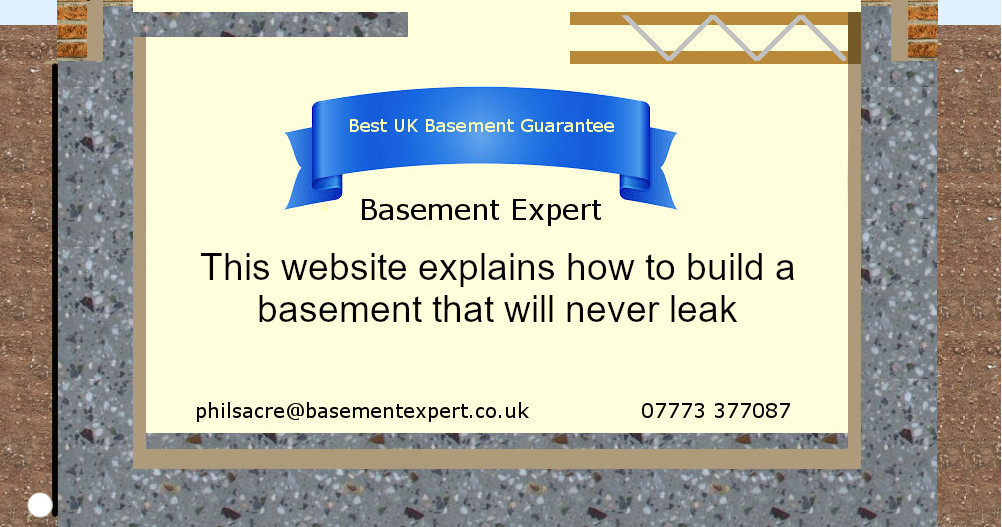|
|
How to Build a Basement
|
|
Dry and without a pump. Without any repairs, ever.
|
|
The Building Regulation you need to comply with is C2."The walls, floors and roof of the building shall adequately protect the building and people who use the building from harmfull effects caused by (a) ground moisture"
|
|
Are you expecting an internal drainage system and sump buried in your basement floor? You must refuse an internal drainage system. Because it covers over leaks; incentivising more and worse leaks; mud; blocked pumps; flood; mould; illness. And it costs a great deal of money.
|
|
If your architect or contractor plan to cover over leaks, C2 is not complied with, and you should be refused Building Regulation approval. Refused your completion certificate. Unable to sell. Because you spent an extra £30,000 on the wrong thing.
|
See the table a short way down this page. It is imperative that YOU ensure that YOUR work is carried out well.
My self-build clients don't have leaks. None. Nothing. My training and supervising self-builders has saved them 70% compared to a main contractor and an internal drainage system - who will probably fail to comply with building regulation C2.
With just this website, some advice from me by email, a little training on site, and supervision of their concrete pours, self-builders have built their basement and it never leaked.
Absolutely none of them have an internal drainage system.
And those who needed a structural warranty and a mortgage got them.
Mostly from Protek or BW BuildWarranty.
More than 100 over the past 20 years.
Please note. I don't go underneath anything already there.
I am about attention to detail because it saves money.
I like to write in simple language as if I was talking to you across a table, explaining my experiences of success and failures.
It is very difficult and extremely expensive digging down further and constructing an RC pit to house a sump under your basement floor. I avoid an internal drainage system. I avoid repairing leaks, which if water is already coming in are impossible to repair.
I guarantee YOUR work won't leak if you go along with me, and I will repair your leaks for free if you did it my way. I hope you can understand that if you don't listen, I have to withdraw myself and that guarantee.
My successful ways are popular with self builders. My ways are not popular with developers or contractors.
-
Contractors want profit. Profit is income less cost, so they cut costs. Leaving you leaks.
-
Developers want to cover over the mistakes, the leaks, and sell urgently to reduce borrowing at the bank.
|
|
|
There is such a lot you might want to know, either now or in future.
Two menus are opened by clicking on either image below.
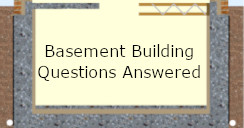
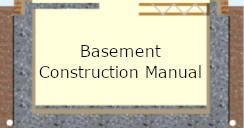
I will answer all your questions by email: viability, what works and what won't, explain and critique what others are telling you, look through your drawings and soil report, etc. for a fixed fee. Find out more here

ARE YOU CONCERNED ABOUT SURVIVAL IN THE EVENT OF UNREST?. It is reported that super billionaires are building luxury bunkers. Not just one. Several in all the areas they spend a lot of time.
|
|
But this has to change because the law has changed. Don't get caught out.
You will soon get used to my asking you to click on a link that will open a new tab. That way, you can continue reading this page anytime and continue reading other pages anytime.
There are new procedures for building control as well, however the new law is the Building Safety Act 2022, which was fully applicable from October 2023. It is a mistake to think this is only about tall buildings. It is about preventing all bad workmanship, and the person who gets into the most trouble, for employing a poor tradesman, is the client.
|
Developers/main contractors don't pay sub-contractors in full
|
Therefore, work is habitually done badly, even for private clients. Has been for generations
|
Both developers and main contractors made money. No one cared about the people who would live in what they built
|
|
Enter: new Building Safety Act. Sub-contractors responsible for reparations for work going back 30 years, regardless of whether they were fairly paid.
|
|
Sub-contractors prefer insolvency to funding reparations
|
They create a new company and carry on
|
Therefore work continues to be done badly
|
|
Building control bodies must now screen sub-contractors for competence.
|
If shareholders start a new company to evade past responsibility, they should not be passed as competent.
|
But private building control hasn't woken up to this yet.
|
|
Will private building control bodies soon be going into insolvency to evade costly repairs? 2nd November 2025 Assent, Oculus and LB Building Control all went into liquidation. Gone. Part-built homes unsure about their warranties, mortgages, and completion certificates. My advice is to use the local authority. More here.
|
|
What of structural warranty providers, such as NHBC, Premier Guarantee, Build Zone, and so on? How are they going to wriggle out of huge claims looming large?
|
|
Self-builders who have never done this before do it easily with my help. Many doctors, dentists, IT people, farmers, two architects building their own homes.
Business people less so, they interfere too much.
Experienced labour tell you they know better and cut corners or make mistakes. Experienced labour need a lot more supervision to avoid repairs later.
I don't ever expect anyone whose work requires them to work down a muddy hole in all weathers to be able to read. On big sites there is always a Site Engineer. This is the educated person half in the office and half down the muddy hole who explains the written details to the men doing the work as they go along.
Self-builders generally seek out and soak up information such as I provide here. The self builder could easily be the site engineer, as long as he is sure that his labour will listen and obey.
Experienced labour do not enjoy reading. They never got beyond the sports pages. They don't read to learn why and how to be mindful of the important details.
Experienced labour were shown all they know.
But they will tell you they spent hours reading this website when they only looked at some of the pictures.
They always worked for the firms who only saw cutting corners and cheating on materials as the way to make a profit.
And that's mainly why they leave leaks. It isn't difficult to change the ingrained habits of experienced labour.
It is impossible.
However, if I give them some training in my formwork and supervise their concrete pours, then they have fewer leaks and leaks that I can repair. I still give you my guarantee if you paid me for 5 visits.
|
|
The trouble with leaks through concrete kickers and honeycombed concrete (that my involvement prevents) is they cannot all be repaired once water is coming through to push off a repair before the repair hardens in place.
If you allow experienced labour free-rein, you are probably always going to have leaks. You chose to have leaks.
Much better to let me supervise. I was a site engineer, myself, for many years prior to 2004.
Mostly, I train and supervise the self-builder.
|
On 15th October 2025, I received an email from bob@btekconcrete.co.uk . A consultant concrete mix designer. Here is part of what he said
I admire the tenacity of people like you who see through the smoke and mirrors and get back to what actually matters - a watertight concrete design.
I couldn't agree more with your principle that:
-
A very dense, low-permeability concrete (with controlled water content, high cementitious content, proper compaction, curing, and supervision)
can act as the waterproofing barrier itself.
-
Many marketed waterproofing admixtures, membranes, or systems tend to mask workmanship defects rather than solve them.
-
And the best admixture on Earth cannot fix a poorly designed, poorly placed, overly wet, or poorly cured concrete element.
Appreciate your work and the clarity of the message. It's refreshing to find someone else who believes that good concrete doesn't
need a sales pitch - just sound engineering and a bit of respect for the mix.
|
|
If you want me to site-manage, I will recruit local young people not in work or training. Show them how. Keep an eye on them. Show them how to be proud of their work. Work toward their first NVQ qualification.
There are almost 2 million young people not in work or training, yet such a shortage of building workers that they are overpaid. I recruit young people locally. Some may only work 3 hours each morning before returning to care for their relative. Others may only work 3 hours from midday because their mental health isn't too strong. That doesn't mean they aren't worth £150 a week. It doesn't mean they can't have a lot of pride and learn to learn. Neither does it mean they have to be male. I pay the minimum wage, and gather evidence for their first NVQ. If a young person gets an NVQ, their next employer will pay them nearly double or they may succeed locally as self employed. This is the incentive I offer. If they skive off I replace them.
An article demonstrating that experienced labour is far too expensive for what you get.
and
Another article stressing that urgent action required on construction skills.
and
London is the second most expensive place to build in the world.
or is it?
London is the fifth most expensive place to build in the world.
Either way, the Home Counties can't be far behind.
|
|
I am definitely slower than experienced labour who 'smash it out'. About 20% slower. But I make that up and more by NOT having leaks, by NOT having internal drainage, by NOT finding that services, walls etc. are in the wrong place by mistake.
BY NOT SPENDING AS MUCH OF YOUR MONEY.
Me, in Sussex, supervising a concrete pour. Most of my work is in the home counties.
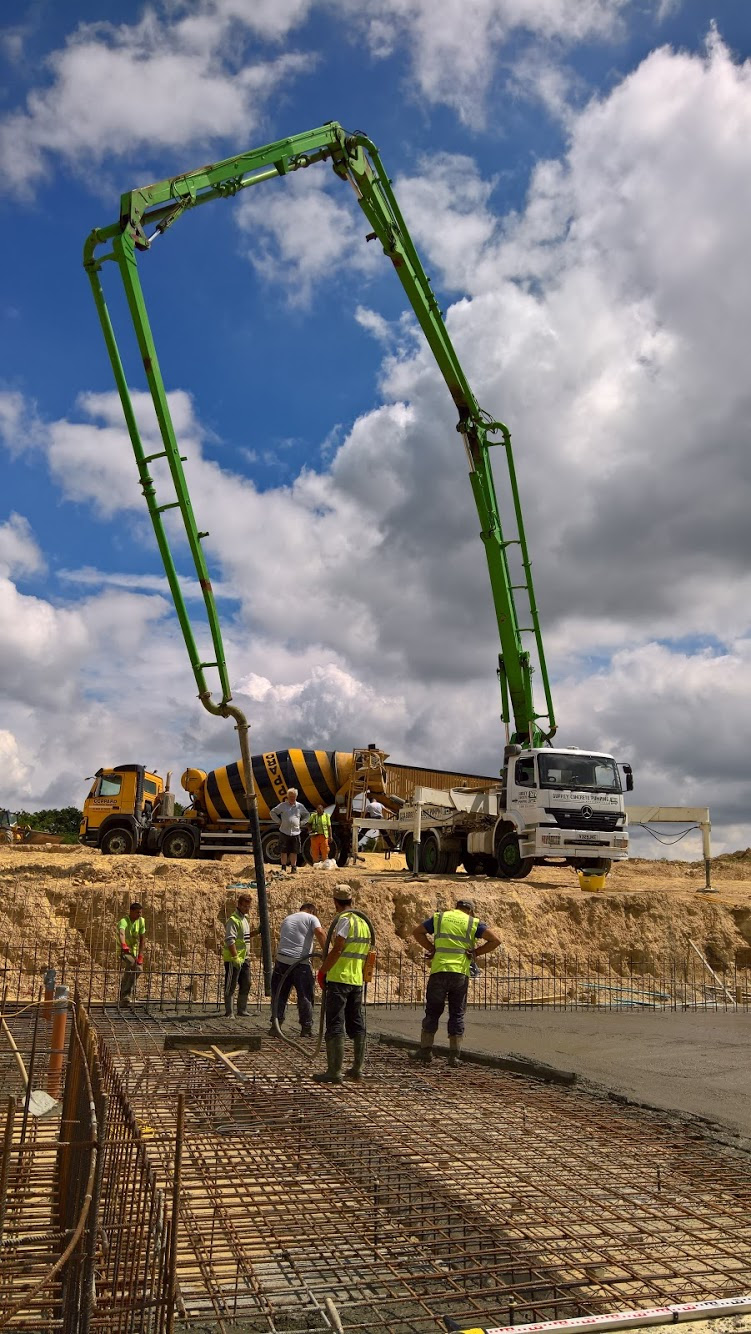
|
|

I can cover the whole of England by email. But I only train and supervise in the South East of England (everywhere East of a line from Derby to Southampton)
excluding London if I cannot drive in easily, or park on site, or park close by outside.
Plus a little bit further along the M4.
I live in Essex.
|
|
On this project in Kent I managed full time a mix of experienced labour and youngsters while I needed them. When I didn't, two of us did it all.
My clients choose the timber based upon what they can best use in the house they build. That way, the formwork is very cheap. My way is simple.
This is me on the concrete pump.
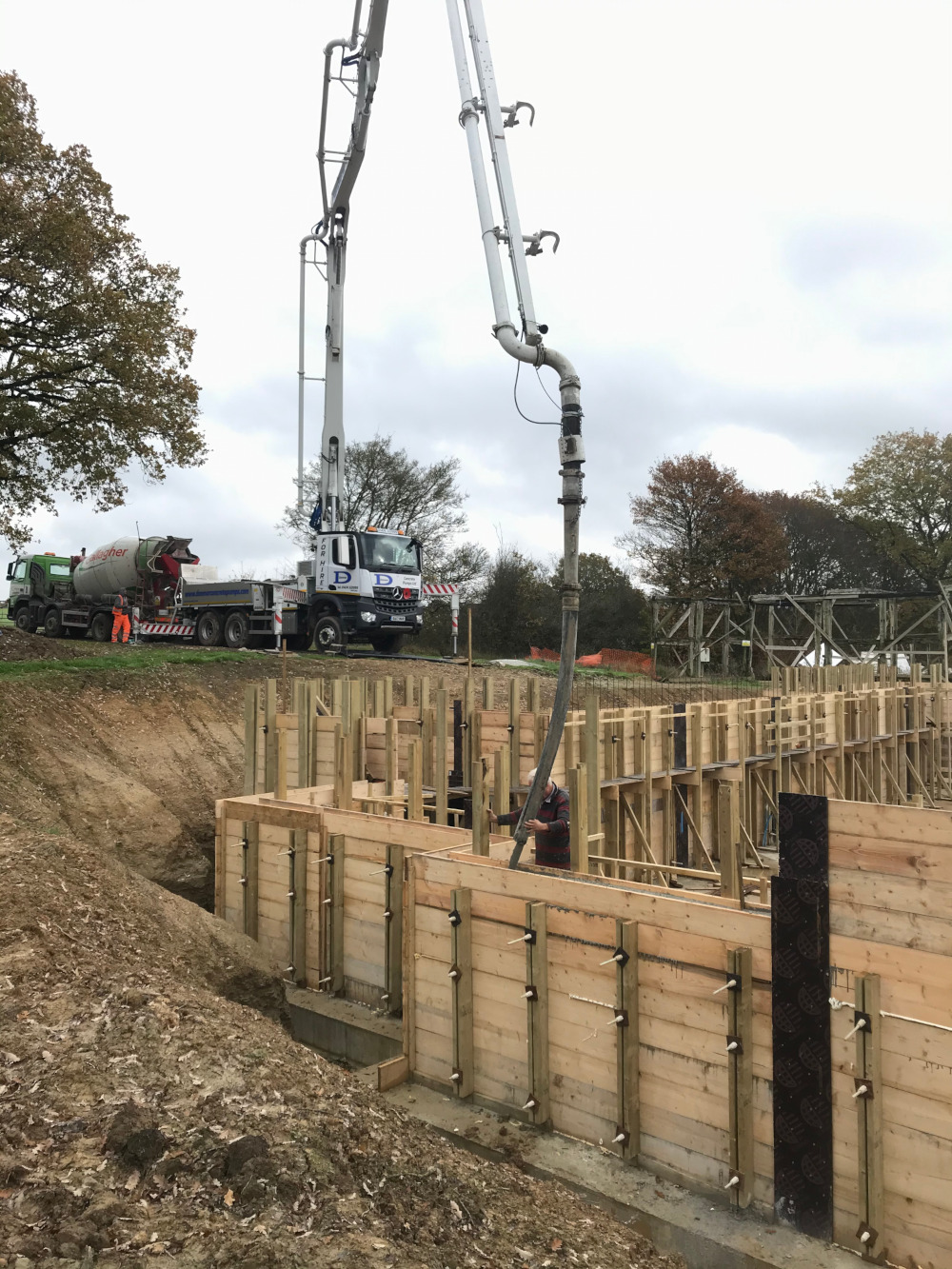
Someone I trust following with my poker
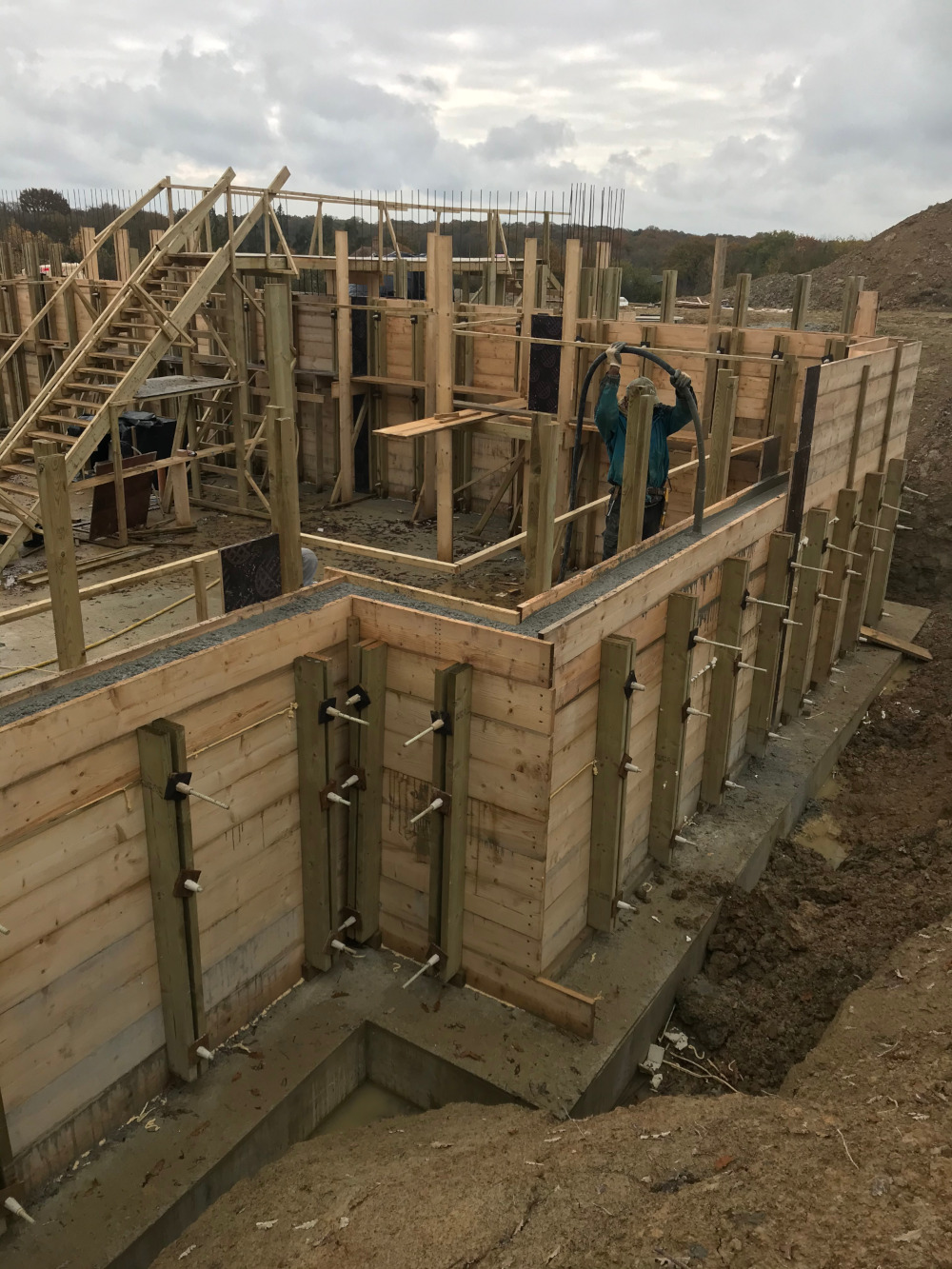
and the same wall a year later with no other waterproofing against the concrete you see poured above.
You can see the slope in the top of the wall below, and the additional timber to create that sloping top in the photo above.
If you used either a hired-in formwork system or ICF you would find that sloping top difficult and prone to bursting.
I know I save a lot of money.
-
I get people working by knowing what they need to do, and avoiding their stopping to have frequent meetings to come to an agreement between themselves.
-
I get people working by showing them how, and I get them up to speed quickly.
-
I prevent errors, which means that those following on don't need to dip in to their contingency fund.
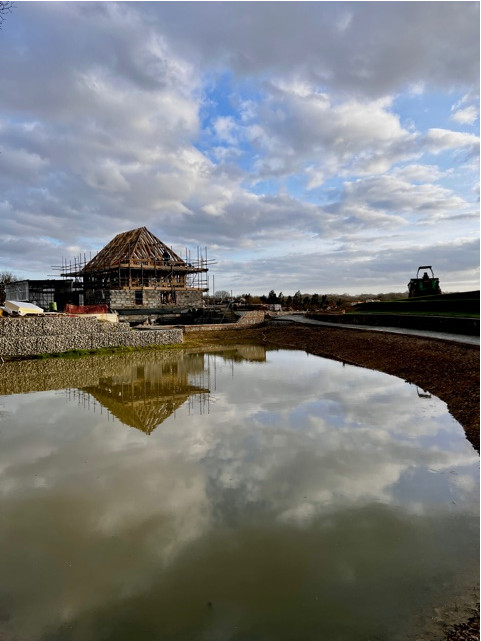
|
|
When this client sent me this photo, he was providing me with a reference for another prospective client, and this is some of what he said
|
|
"we are very proud of the work Phil did for us and how he pulled the project together. The finished result is outstanding.
Phil has extensive experience and all of the civil engineering people we had on our development held Phil and his experience in high regard.
Phil has a very direct manner and gets things done.
Phil always without questions works in your favour.
Phil will save you a lot of money.
As you can see, I can’t speak highly enough of Phil and the work he does. He made such a difference on our development and we have been delighted with the end product. Our development actually sits in water so we needed every confidence we would have NO leaks. I have taken a picture of it today and attached it here. You can’t see the underground elements too well as they are below the water line
I have another house build on our current site that involves concrete near water and Phil will be doing that job too - he does not know this yet but he does now."
|
|
This was the same basement viewed the other way when I returned to pour the concrete ground floor on the steel frame.
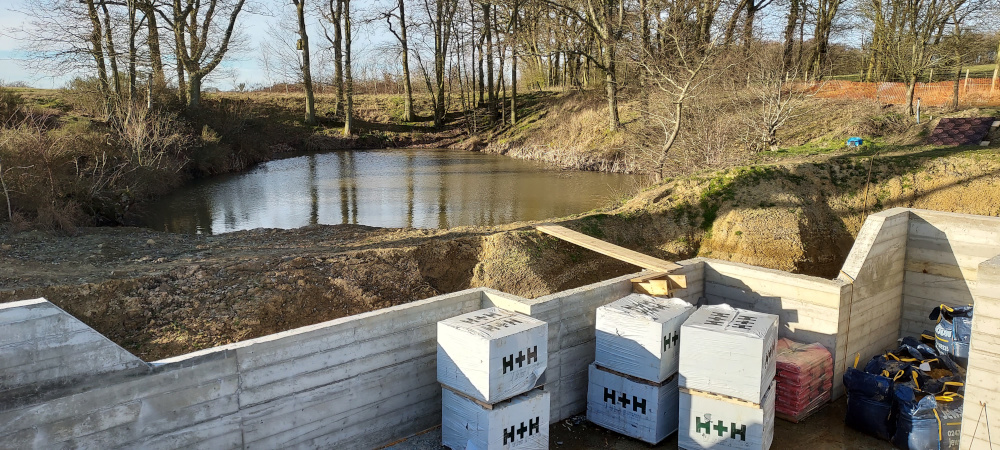
The client kindly sent me another photo showing the progress..
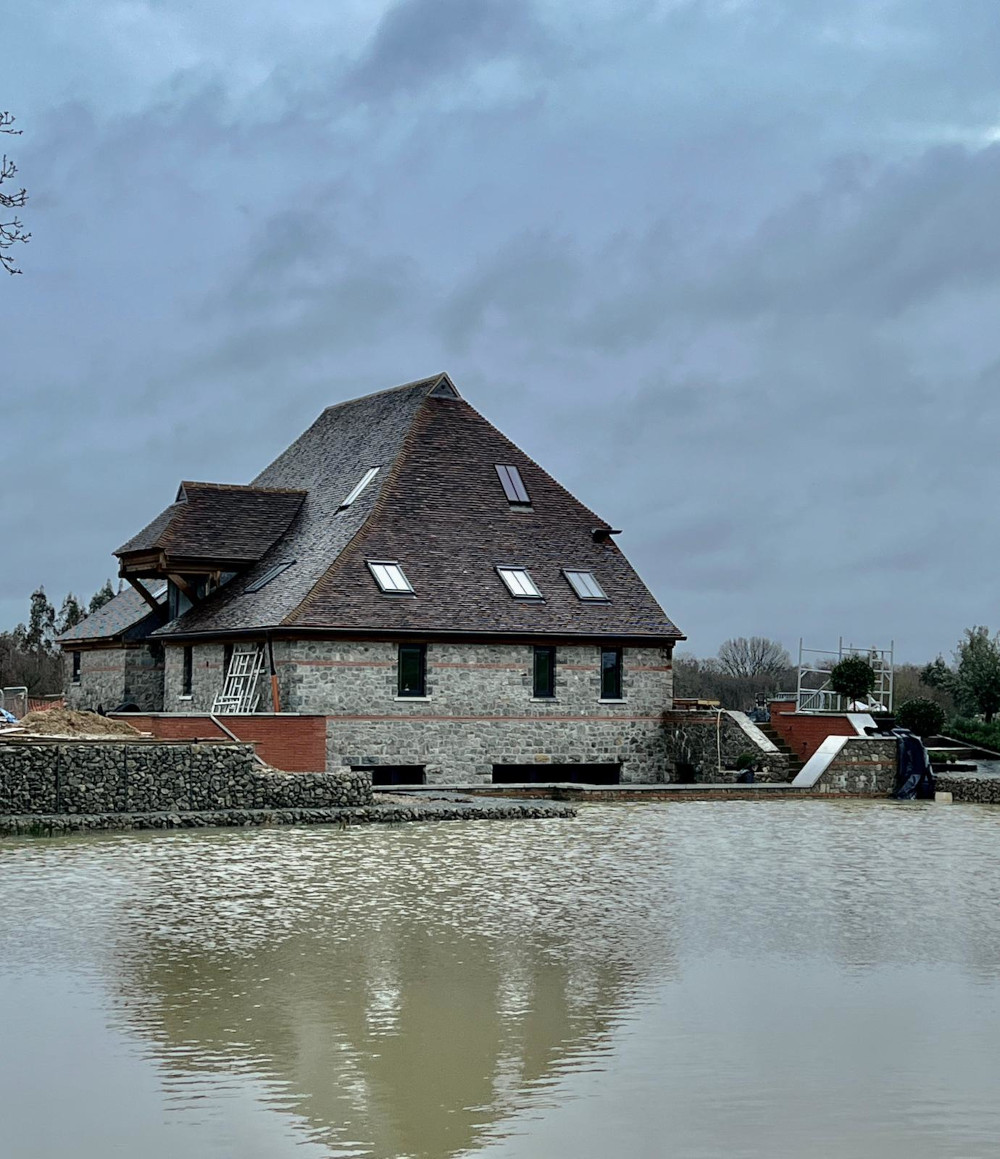
My successful ways are not secrets.
-
Care (experienced labour would require supervising).
-
Genuinely waterproof and leak-proof concrete and joints (which mainly requires care).
-
I must carefully study your architectural and structural engineer designs and remove causes of leaks (more care).
Care will save you a lot of money.
Refer your architect to my page for architects here, and your engineer to my page for engineers here,
There is a lot of nonsense out there about building a new basement.
The Building Regulations say that a basement structure (the floors, walls and roof) must protect the building and its occupants from harmful effects. That would include mould following a flood. Floods are usually only after an internal drainage system failed because the contractor left leaks that let in mud that blocked the pumps (despite sticky-back membrane that someone tore but didn't repair).
If anyone tells you you need internal drainage, tell me. I will email them and explain why they are wrong.
A couple of recent changes you might need to learn about, because I still find inspectors, insurers, architects, and engineers aren't all up to date. Particularly NHBC who, for some reason I cannot explain, belong to the Property Care Association that fixes problems in old buildings. That seems to be why NHBC wants your new basement to have problems and for you to fix them.
-
The Grenfell Tower fire has caused a lot of changes. All effective from October 2023.
-
Building Safety Act 2022, which includes improving workmanship.
-
Legal requirements, such as the client is legally bound to only employ competent people.
-
Legal responsibilities. Such as only using suitable products.
-
Building control procedures. Building Control must file away evidence for use in court later.
-
Proving competence before work is allowed to start. Building control should prevent you continuing with incompetent people, and
-
Each contractor proving to the architect they did their work properly as their phase ends.
-
In 2022, the British Standard BS8102:2022 changed. Now, it champions my methods over internal drainage.
-
It says: fix all the leaks.
-
It says: Grade 3, habitable accommodation: No water ingress or damp areas is acceptable.
-
It says: an internal drainage system does not waterproof and is not a waterproofing defence (in a new-build project).
The Standard does not want you to let any water in.
The Standard does not approve of anyone selling internal drainage or sticky-back membrane being your architect's waterproofing specialist. Neither internal drainage nor sticky-back membrane should be on your drawings, because they are both known to fail.
From Part C of the Building Regulations "Site preparation and resistance to contaminants and moisture".

|
|
I wrote to Dame Judith Hackitt and received this response from DLUHC, explaining regulation C2 and the British Standard.
|
If your new domestic basement is a single or double storey structure built and proven not to leak at all, it is compliant with Building Regulation C2 and BS8102:2022, and you should not have to explain any other detail to anyone.
You should demand that your new basement structure is inspected after it is weatherproofed (roof and windows complete) cleaned and dried and after a period of heavy rain. Nothing should cover the basement structure, inside, before it is known not to leak.
As the letter says, if anyone wants you to depart from the Approved Document (BS8102:2022), they must "demonstrate that the Building Regulations requirements have been met by some other acceptable means."
I invite you to prepare yourself for some tough conversations with your architect, your building control body and your insurer (unless you use Protek) about this, because they are all likely to want internal drainage, which is the very product that was demoted within the Standard because it covers over and hides bad workmanship by contractors, allowing leaks, allowing mud, allowing floods, and causing ill-health. Internal drainage causes the law to be broken.
You have me, this web site and all its evidence on your side to help you.
It is so important to prevent leaks because not all leaks can be repaired. Leaking concrete kickers cannot be repaired. Honeycombing cannot properly be repaired. Both of these leaks are structural defects as well. Hundreds of tie bar holes can be repaired but some will be missed. Cracking can continue for years if the structural engineer fails to address cracking fully - and many don't address cracking at all.
The best approach, by far, is to build without leaks and sufficient steel reinforcement to prevent cracks.
Your team starts with your architect. It includes your building inspector, and it includes your workforce - which might mean a main contractor and a sub-contractor.
My page about being your Waterproofing Specialist to BS 8102:2022 here.
You can click on the Menu Page buttons above (and at the bottom) to access all 63 pages.
You can read to the end of any page and click on the Next Page button.
Every basement build is different with its own special problems that only come to light as you do the work. Success requires experience. I am the experience you need without making a fortune out of you.
I live in Essex and I am happy to travel anywhere in the Home Counties, down to Southampton and North to Nottingham and Derby.
But I do not like going into London.
|
|
I am not registered for VAT
New dwellings can get all the VAT back from building costs but not from design, management or hire costs.
I will bill you personally for everything you get from me, free of VAT.
Please Note.
I don't give anyone credit.
|
I would like your new basement to be designed with my details, free of charge if you or your design team find the details here on this website.
I am a site guy. I don't want to be a formal member of your design team, discussing all the iterations.
Instead, I would like to be your basement waterproofing specialist responsible for the work on site to all be correct, until your basement structure is complete and your new basement not to leak - anything, ever.
Call me, Phil Sacre:
Email me: philsacre@basementexpert.co.uk
(I had an email link, but security at my domain server won't let it display on your screen).
This Home Page is where you find my menus to all the other pages.
Two menus.
The first menu is your basement planning questions answered. The second menu is your basement construction manual.

|
|
This section is discussing how you might build and which methods and products available I would tell you not to use.
The next section is how to self-build yourself.
|

|
|
This second menu is intended to be a complete build manual to build a new basement structure waterproof from the reinforced concrete alone.
|
Back to the Basement Building Questions Answered

|
Forward to the Basement Building Construction Manual

|
For a fixed fee of £199 I will answer all your questions by email. More details here.

|
|
|
Next Page
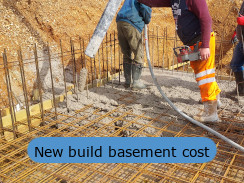
|
|
The Page After That

|
|
|
|
